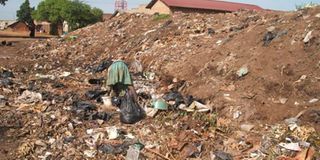Namatala, a haven for the poor

A woman searches through the garbage dump in Namatala slum in Mbale municipality. Photo by David Mafabi
What you need to know:
Life in the slum. Besides the sanitary conditions the slum dwellers face, they are also stigmatised over crime, drugs and alchol abuse, writes David Mafabi
I t is a bright and hot day as the scorching sun is bearing down upon Namatala, a suburb in Mbale Municipality. Voices of children playing in the quarters echo in the shallow alleyways winding through the dilapidated structures that are a common sight when you reach Namatala slum.
The slum is composed of mainly round huts made with mud and thatched roofs. There are some bigger, rectangular ones – but these are sub-divided into rooms so that one family occupies space of the size of a small village kitchen.
The first time I walked through the area, I detached myself from the situation because I did not want to be emotionally hurt by seeing others’ needs. However, it is difficult not to become emotionally attached because the situation inspires a passion and love for the people so that I am devoted to doing everything about it.
Like other slums in the world, Namatala is inevitably occupied by poor people and families who have nowhere else to live. It is a squalid area comprised of cheap, dilapidated structures and streets are narrow and blighted.
The living conditions are deplorable, with landlords often failing to maintain the structures.
Inhabitants
According to the Mbale City Profiling Report, Namatala is the largest slum in Mbale Municipality. It has a combination of inhabitants, including Bagisu, Bagwere, Basoga, Iteso, Karimojong, Acholi and Langi, among others. Many settled here because of civil unrest, drought, natural disasters such as floods and landslides and in search of employment. However, todate, they are still grappling with problems.
Ahmed Kutosi says because of the nature of houses built and pit-latrines, sanitation standards are wanting, right from the leaders to the residents. On arrival at the home of the village chairperson, John Byansi, the stench of human waste fills the air.
The pit-latrines are in a poor state and yet they cater for more than 30 people since many landlords construct more than five single rooms that house an average of five people in each.
Hakazia Maludye, a resident, says most people in Namatala don’t have pit-latrines, instead, they help themselves in polythene bags and litter them near the homesteads and on garbage bins provided by municipal authorities.
“Our pit-latrines are not controlled by anyone in particular and many are full, squalid, overflowing and prone to causing health hazards. The bathrooms are equally in bad shape with many made of polythene sacks and pieces of old iron sheets with bad floors,” Muludye says.
Although many people have access to clean water through communal taps, most landlords charge Shs300 per jerrycan, which some tenants cannot afford.
“Therefore, many people still resort to collecting water from the nearby River Namatala. Unfortunately, the river has claimed so many lives, especially of children who go to wash, fetch water or swim,” says Maludye.
Diana Nandawula, the Mt Elgon police spokesperson, says they have registered cases of children drowning in Namatala but their advice to encourage people to vacate the place have always fallen on deaf ears.
“We do postmortern for the bodies recovered and usually urge people to stop living around the banks of River Namatala and sending children to the river to fetch water but they don’t learn,” says Nandawula.
Stigma is also something the residents have to deal with daily.
Jane Nabukwasi, a resident of Nkoma, an adjacent slum, says the area belongs to a stigmatised racial or ethnic group and that ones’s address becomes a prestigious status symbol if one lives in an area reserved for the “right” kind of people.
“And such class consciousness coupled with aversive racism creates a related motive for concentrated poverty, fear of declining property value and/or the desire for property value appreciation,” Nabukwasi says.
“We are usually seen as harmful threats to community health and stability, for instance lowering the quality of schools, raising the crime rate, spreading disease, not keeping up their yards or homes,” she adds.
“And all attempts to exclude us from all Nkoma and Kiteso are made, which if successful leaves us in areas of highly concentrated poverty and landless, that is the fear we have.”
Some NGOs such as Jenga CBO, Child Restoration Outreach, Child of Hope, Uganda Slum Dwellers Federation, PONT Uganda and ACTogether, are implementing projects in the area, but much still needs to be done.
Muwalib Zandya, the municipality mayor says there are plenty of problems that have project possibilities: water, sanitation, prostitution, child abuse and abandonment by the fathers. “What is killing people in Namatala are the new landlords who are pushing the poor away towards the river,” he notes.
The LC5 chairman, Mr Bernard Mujasi, says slum land is much sought after because it is cheap thus rendering some inhabitants homeless. Like Namatala, Nkoma is slowly disappearing as the land near the Islamic University in Uganda is being developed for business.
Byansi says slums developed in Namatala when rich people built crowded substandard housing on the cheapest land and rented it to poor households with earnings too low to allow them to live in better apartments.
“The slum dwellers are selling off their land because of poverty and in other places, land is being taken by the municipal council for development,” says Byansi.
However, the village chairperson adds that one must not romanticise slums as bastions of salt-of-the-earth authenticity; all too often life in them is short and brutal, with miserable living conditions and wasted human potential.




